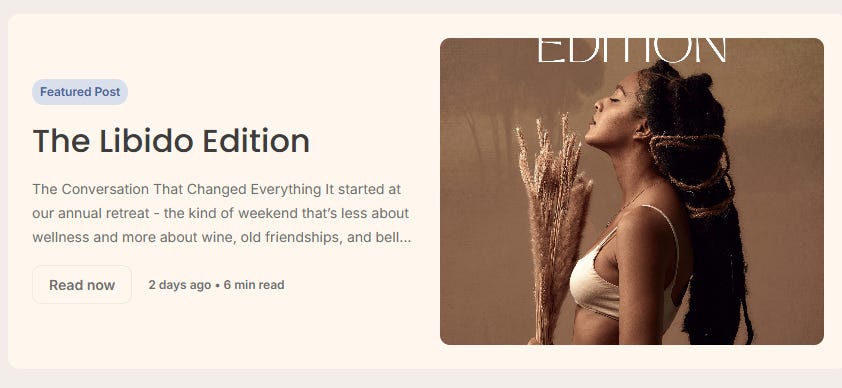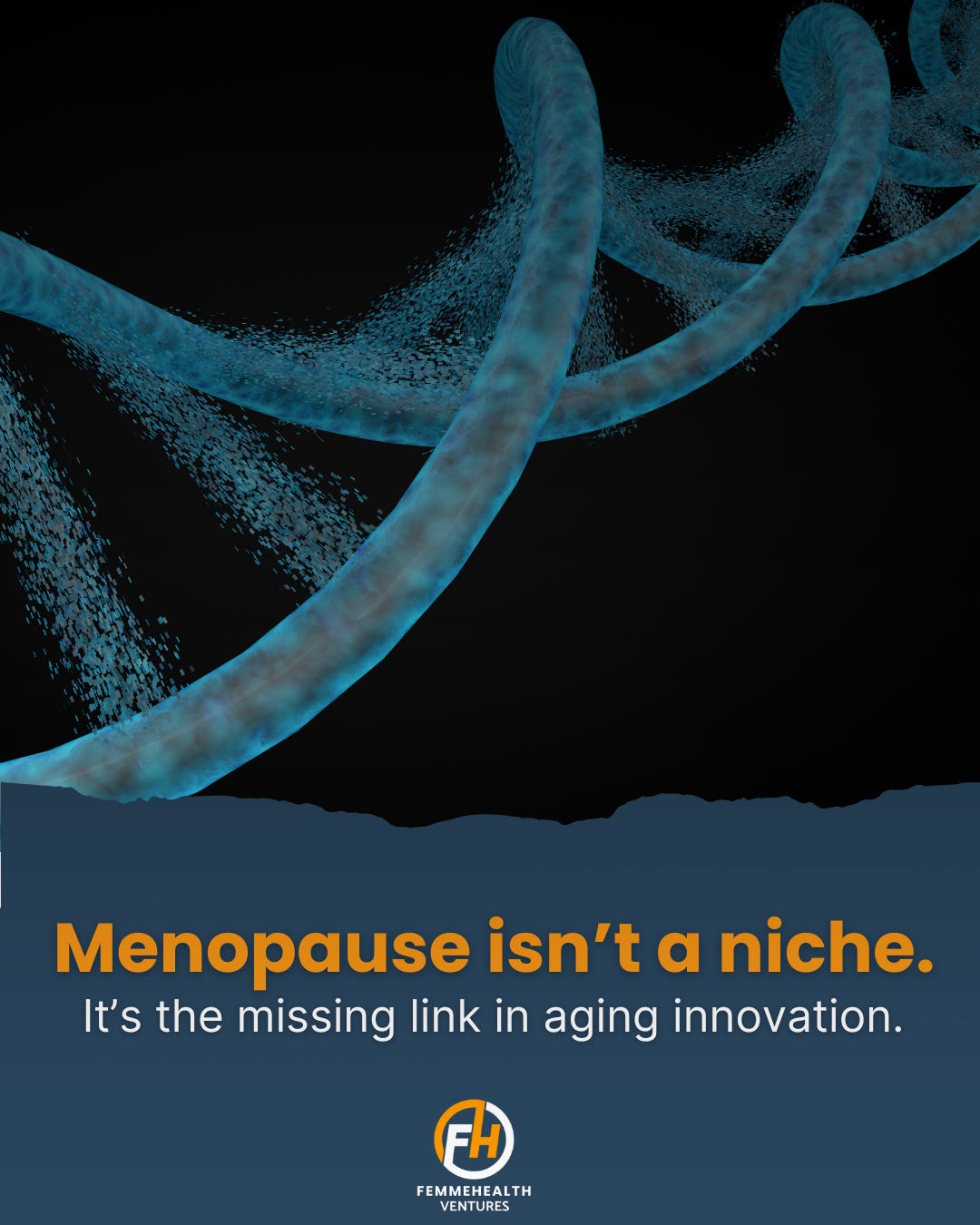Longevity Misses the Mark: Why Menopause Is the Blind Spot in Aging Science
Women live longer but age worse. Why capital markets and medicine still ignore the biology behind midlife risk.

This newsletter is 100% free. But it takes hours each week to research, write, and produce at this level. Here are 5 ways to support my work: 1. click “❤️” to amplify 2. subscribe 3. share this publication 4. buy me coffee 5. become a partner
Connect and collaborate with me here! Email | LinkedIn | Instagram
In 1929, the American tobacco industry launched a campaign so iconic it rewired consumer psychology: Lucky Strike cigarettes were branded as “torches of freedom” for women.
That year, Edward Bernays, the so-called father of public relations, hired debutantes to light up during the Easter parade in New York, framing it as an act of feminist rebellion1.
It worked. Smoking among women surged. But so did lung cancer2.
This is what happens when cultural narrative outpaces medical infrastructure: we celebrate visibility without re-engineering care. And in many ways, longevity is repeating that pattern.
Today, we are told that aging is a triumph. And it is. But it’s also a science problem we haven’t finished solving, especially for women.
Women live longer than men. Yet their quality of life in those additional years often plummets3. This is not a mystery of nature. It’s a failure of the system. For decades, medicine and capital alike have treated menopause as a lifestyle inconvenience rather than a biological inflection point.
The result? A blind spot in the very engine room of longevity investing.
This is Part 1 in a five-part series on why longevity needs a gender lens. To go deeper, preorder my upcoming book The Billion Dollar Blind Spot and help rewrite the future of women’s health and aging.
Get Early Access to my upcoming Book - The Billion Dollar Blind Spot
But first…
This week in Institutional Investor
This week, I wrote an op-ed for Institutional Investor about what happens when public capital steps back especially in women’s health.
It’s something I’ve seen up close: the way underfunding becomes invisibility, and invisibility gets mistaken for low value. This piece means a lot to me. It’s about how systems misprice care and how that distorts the future.
Read it here if you would like to go deeper
The Future Woman Brief is here
So many of you asked for something deeper. Something that meets women where we are; midlife, full of questions, navigating a health system that often overlooks us.
I heard you.
The Future Woman Brief is my new monthly email. It’s science-backed, product-aware, hormone-smart and it takes your health seriously.
The first edition is now available. It’s called The Libido Edition and it’s a powerful starting point.
Back to Today’s Essay…
We Built the Longevity Market But Forgot the Female Biology
Most longevity frameworks are built around biomarkers, senescence, metabolic slowdown, and inflammation4. What they miss is the massive physiological recalibration women undergo in midlife. Estrogen affects the brain, bones, heart, muscles, and immune system5. Its withdrawal is not just a hormonal event. It’s a systemic shift that touches nearly every aging pathway being targeted by biotech.
And yet menopause is largely absent from institutional memos on aging6.
We get white papers on NAD boosters. We get age clocks calibrated on male data. We get excitement about AI for “predictive health,” but none of these tools flag what millions of women feel in their bones: that their bodies are changing rapidly and often painfully and that no one in charge seems to care.
The Mispricing of Midlife Risk
In capital markets, timing matters. You don’t invest at random. You invest at the right inflection points.
And if we applied that logic to the female lifespan, menopause would be blinking in red. It’s the moment risk explodes - osteoporosis, cardiovascular events, cognitive decline7, and it’s also when health-seeking behavior peaks as recent research spanning over 4,400 U.S. women shows a marked rise in consultations during perimenopause when symptoms intensify and age approaches menopause8. That’s a market signal.
But we’ve normalized the idea that this phase is just “part of being a woman.” As a result, we have ignored one of the most actionable, high-impact entry points for preventive health innovation. Not only is that a strategic miss. It’s a human one.
❤️ Enjoying this? If this post sparked something for you, click the ❤️ at the bottom. It helps more than you know and tells me you're reading.
From Taboo to Thesis
Some might say: “But menopause isn’t sexy. It doesn’t scale.” That’s the same argument that kept women out of clinical trials for decades9. It’s the same logic that said ED was an urgent market, but hot flashes were not10.
In reality, the menopause market is expected to reach $24 billion globally by 203011. But this figure underestimates the true opportunity. Menopause is not a niche. It's a gateway. A predictive marker for aging risk. A reset moment for metabolic, cognitive, and cardiovascular trajectories. And, increasingly, a trigger for women's economic disengagement12.
It’s time we stopped thinking of menopause as a “theme” and started recognizing it as a systemic market lever.
Let’s Rebuild Longevity With a Gender Lens
If we want a real longevity economy, we need to stop treating women’s biology as an afterthought. Aging is not just about years. It’s about function, independence, cognition, participation. And for half the population, that trajectory is profoundly shaped by menopause.
It’s time to stop leaving that out of the investment deck.
Preorder the upcoming book The Billion Dollar Blind Spot to learn why women’s health is the future of healthcare investing.
Share this if you believe longevity isn’t gender neutral.
Join Our Network
Are you building or backing credible, under-the-radar solutions in women’s health?
We want to hear from you. Reach out privately or reply to this post. FHV curates brands and breakthroughs that deserve broader attention in the women’s health ecosystem.
Coming This Month:
🎧 Blindspot Capital: The Podcast
Formerly FemmeHealth Founders, our podcast relaunches this summer under a sharper lens and a bolder name. Blindspot Capital explores the undercurrents shaping health innovation from the deals that stall to the systems that silence. This season, we speak to the people shifting what gets seen, funded, and scaled.
👉 Subscribe to Blindspot Capital wherever you get your podcasts, or listen directly on Substack.
I write weekly at FemmeHealth Ventures Alliance about capital, care, and the future of overlooked markets. If you are building, backing, or allocating in this space, I’d love to connect.
Disclaimer & Disclosure
This content is for informational and educational purposes only. It does not constitute financial, investment, legal, or medical advice, or an offer to buy or sell any securities. Opinions expressed are those of the author and may not reflect the views of affiliated organisations. Readers should seek professional advice tailored to their individual circumstances before making investment decisions. Investing involves risk, including potential loss of principal. Past performance does not guarantee future results.
Tye, L. (1998). The Father of Spin: Edward L. Bernays and the Birth of Public Relations. New York: Henry Holt & Co.
U.S. Department of Health and Human Services. (2001). Women and Smoking: A Report of the Surgeon General. https://www.cdc.gov/mmwr/preview/mmwrhtml/rr5112a4.htm
Crimmins EM, Beltrán-Sánchez H. Mortality and morbidity trends: is there compression of morbidity? J Gerontol B Psychol Sci Soc Sci. 2011 Jan;66(1):75-86. doi: 10.1093/geronb/gbq088. Epub 2010 Dec 6. PMID: 21135070; PMCID: PMC3001754.
López-Otín C, Blasco MA, Partridge L, Serrano M, Kroemer G. The hallmarks of aging. Cell. 2013 Jun 6;153(6):1194-217. doi: 10.1016/j.cell.2013.05.039. PMID: 23746838; PMCID: PMC3836174.
Brinton RD, Yao J, Yin F, Mack WJ, Cadenas E. Perimenopause as a neurological transition state. Nat Rev Endocrinol. 2015 Jul;11(7):393-405. doi: 10.1038/nrendo.2015.82. Epub 2015 May 26. PMID: 26007613; PMCID: PMC9934205.
Walsh, J. (2024, January 10). How gaps in scientific data lead to gaps in care for aging women. Harvard Medical School. Retrieved from https://hms.harvard.edu/news/how-gaps-scientific-data-lead-gaps-care-aging-women
Mosconi, L. (2020). The XX Brain: The Groundbreaking Science Empowering Women to Maximize Cognitive Health and Prevent Alzheimer’s Disease. Avery.
Sayer, L., et al. (2024). Perimenopause symptoms, severity, and healthcare seeking in a U.S. cohort. Nature Aging. Retrieved from https://www.nature.com/articles/s44294-025-00061-3
Liu KA, Mager NA. Women's involvement in clinical trials: historical perspective and future implications. Pharm Pract (Granada). 2016 Jan-Mar;14(1):708. doi: 10.18549/PharmPract.2016.01.708. Epub 2016 Mar 15. PMID: 27011778; PMCID: PMC4800017.
Grand View Research. (2023). Menopause Market Size, Share & Trends Analysis Report. https://www.grandviewresearch.com/industry-analysis/menopause-market







Another area of grave neglect is a woman's life post hysterectomy. Especially for those of us with a cancer history.
And doctors woefully ill- equipped to prepare, advise or treat.
The most infuriating being the years of dismissiveness...probably due to a lack of knowledge, training or resources.
Love this framing—menopause as a market signal and a human one. In my work, I see every day how treating it as a ‘lifestyle inconvenience’ robs women of both agency and dignity. Thank you for naming this.